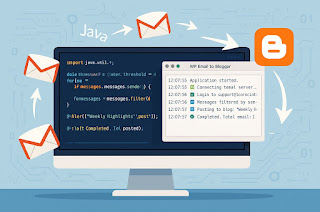I)Introduction:
The company
pioneered the use of web services to connect software applications together
within a single organization and across the Internet.
II)Focused On:
1)Application Integration.
2)Business Process Integration.
3)B2B Partner integration.
III)Basis:
It is based on the idea to use the new standards of the Web
such as HTTP and XML to allow software applications to communicate with one
another in a real time.
Series of development consist of:
1)Web Automation Server.
2)Web Methods B2B Integration Server.
IV)Basic Function of this software:
It is basically an “engine for running
services” .A service can be viewed as a black box which performs some
computational function. It takes in required data, required messages and generates the output as required by the
required computation.
The Web method integration server is a service engine
therefore to IS, everything is viewed as a service.
V)Other Components
of it are as follows:
1)Integration
Servers:
It is the engine for running services .Many other modules
are used as an add on the integration server on the top of the IS. Some of the
examples are Trading Networks, Flat File Handler and Business Process
Modeler as well as
the administrative GUI’s for other modules.
Features of the Integration Server is
as follows:
a) An engine for
running local services, distributed services, web services.
b) A client enabler
to invoke local services, distributed services, web services.
c) To bind two disparate systems.
d) An XML parser and generator.
It uses the Webmethod
Flow Procedural Statements which are :
1) MAP(assignment statement).
2) BRANCH(decision statement).
3) LOOP(iteration statement).
In addition the flow language has the following extra 4
statements:
4) INVOKE (subroutine call).
5) SEQUENCE(compound statement)
6) EXIT
7) REPEAT(another iteration)
2) Trading Networks:
It is a service that
acts as an interface between the internet and the Webmethod . It tracks down
data between the multiple external
partners and an integration server.It performs task such as
a)Authentication
b)Authorization
c)Document
Identification
d)Logging and activity monitoring.
It can be viewed as a
generalized document router, but in reality it acts as simply another service
running with the integration server. It can be invoked via a variety of
mechanisms such as HTTP, FTP, SMTP, Web Services ,java client or via
publish/subscribe.
3)Broker:
It acts as separate
server which helps to pass data between the multiple instances of the
integration Server. In it a service publishes a document to the broker and the
broker delivers the document to all services that subscribe to the document.
The Broker performs routing of messages
in a reliable and efficient manner.
4)JAVA Service:
Java is used to write
for all the services except the running services. The cases when java should not be used to write
services are as follows :
1)The Webmethod
developer does not provide an IDE for
java.
2)Java program cannot
easily manipulate the pipeline which is used by integration server to pass data
among services.
3)Java is harder to
implement in comparision to the flow language.
VI)Webmethods Installation:
Its products are not
free and the cost goes up high to have it. The products can be installed from the internet if you
have an access to the appropriate license key.
An installer program
WebmethodsInstaller651.exe is needed to access the installation files.
The installation choices
are as follows:
a)We can deploy the
products online on a single machine kust by opting out for the prompts
interactively or via a script file.
b)We can download
products to a image file which can be later used for the local deployments,by
answering prompts interactively or via a
script file.
VII)Hardware Configuration requirements:
a)2-3 GHz CPU.
b)1-2 GB RAM
c)40-80 GB HDD.
d)Compatible with both
Unix and Windows OS(Unix is favored for the production system but windows is
better for an experimental purpose).
e)A Database(For example
Oracle or SQL Server)
VIII)webMethods Products :
It produces a lot of the
products that focuses on
a)Enterprise Application Integration
Market(EAI):
It is concerned with
integrating disparate systems such as application servers (SAP, Seibel,
Peoplesoft ),
Database management systems(Oracle, SQL Server, DB2),mainframe
and custom applications(J2EE).
b)Business-to-Business market(B2B):
It is concerned with
enabling separate companies to exchange
electronic documents , such as purchase orders ,invoices, etc .
IX)Notes(Concepts
to be known):
1)XML-RPC: It
works by sending a HTTP request to a server implementing the protocol.
Client(software)------------------------->Server(That
implements that protocol)
(HTTP Call)
In this multiple input parameters can be passed to
remote method, but only one return value
is returned.
2) WIDL (Web Interface Definition Language) is a
1997 standard for interactions between websites.
X)References
are as follows:



No comments:
Post a Comment